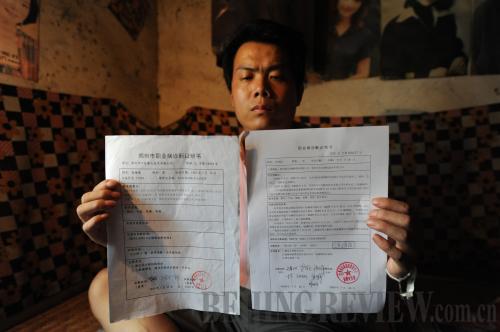|
 |
|
NEWSMAKER: Zhang Haichao, a factory worker from Henan Province, shows his medical certificates on July 27, 2009. In July 2009, Zhang demanded doctors open his chest to confirm he suffers an occupational lung disease after local occupational disease control center failed to recognize his worsening conditions (ZHAO PENG) |
It seems everybody loves cool gadgets like the iPhone and iPad manufactured by Apple Inc. However, there is constant darkness behind the shining glory.
For the latest instance, Apple released its Supplier Responsibility Progress Report 2010 in February, admitting that 137 workers at the Suzhou facility of Wintek, one of Apple's suppliers in China, had suffered adverse health effects as a result of exposure to n-Hexane, a chemical found in products used to clean the touch screen of Apple's iPhone products.
The Apple-involved scandal again focused a spotlight on the issue of occupational diseases, which have taken the lives of 137 gold mining workers in Shangshan Township in Xiushui County, Jiangxi Province, since 1994 when the pneumoconiosis was first detected there.
"It's a land that has been cursed," said an anonymous medical expert after he had inspected the township for pneumoconiosis, a deadly disease that is slowly killing local villagers. There have been 489 villagers diagnosed with the disease (137 already dead) and 152 suspected cases.
Pneumoconiosis, or what is sometimes dubbed as "black lung" disease, is a chronic disease caused by long-term exposure to coal dust and other harmful materials. A large number of Chinese miners, especially those working in small and medium-sized mining companies with substandard working facilities, fall victim to the disease. It is currently one of the most common occupational diseases in the country, said the Ministry of Health in April 2010.
In 2009, 18,128 cases of occupational diseases were reported to health authorities at all levels, up 32 percent over the previous year, the ministry said. Black lung disease cases accounted for 14,495 of them, representing an annual growth of 34 percent.
In that year, 124 migrant workers in Gulang County in Wuwei City, northwestern Gansu Province, were diagnosed with black lung disease. A third of them are in critical condition and three are already dead.
In July of the same year, Zhang Haichao, a factory worker from Henan Province, demanded doctors open his chest to confirm he had the occupational lung disease after the local health authorities denied him free treatment and compensation from the employer.
On a larger scale, the Ministry of Health released figures showing that about 200 million laborers face the threat of developing ailments in the workplace in about 16 million enterprises in which poisonous and harmful materials are used.
The ministry said it had recorded more than 500,000 cases of occupational disease or injury since 1978 and the number is rising.
The fragile network
"Though it's a matter of life and death, occupational diseases are rarely acknowledged by the general public. Many mistake common office ailments, such as pain in the neck or lower back, as occupational diseases," said Zou Wei, who works for the Occupational Disease Network, an influential website in China that is dedicated to providing information that's related to working hazards and helping occupational disease sufferers obtain compensation and protect their rights.
"A real occupational disease is a chronic ailment that occurs as a result of work or occupational activities. Black lung, chemical and metal poisoning and radiation poisoning are the most common," said Zou. "Learning what occupational diseases are is only the first step to helping sufferers solve their problems."
Poor public awareness put aside, the country's abilities to prevent and treat occupational diseases are lagging behind needs.
A Xinhua report shows China has fewer than 500 medical institutions capable of diagnosing occupational diseases and 2,272 occupational health check-up centers. Only 12 of the 31 provinces, autonomous regions and municipalities on the Chinese mainland have independent prevention and control institutions for occupational diseases.
But, the government is picking up speed in strengthening medical facilities in this regard. At a working conference in February, Vice Minister of Health Chen Xiaohong urged all provinces to set up independent institutions for occupational diseases by the end of this year. He also required all prefecture-level cities to set up check-up centers that can diagnose occupational diseases.
Uneasy compensation
There are more problems than the limited number of medical institutions to cure occupational diseases. The unusually lengthy procedures required for occupational disease diagnosis lead many patients to miss the opportunity to claim compensation from their employers.
In 2002, China enacted the Law on the Prevention and Control of Occupational Diseases to protect workers in high-risk industries. Employers and insurers are mandated to award patients compensation upon certification by government-designated occupational disease control centers. But some regulations dictate patients must be diagnosed as having an occupational disease at a hospital, which could mean a process that could last for three months.
Patients also have to get local labor authorities to identify their diseases were caused by their current working environment, and such a procedure could last for months as well. Then they have to wait for another two to three months before their disability level caused by the recognized disease is rated.
It's reported that Zhang Qiang, a former hotel worker, had to wait 1,461 days before receiving a work-related injury identification letter. The 56-year-old man had his feet and legs burnt by a toxic chemical while working for a state-owned hotel in Beijing. He said the wait was too heavy a burden. As a result, he was never properly compensated because of the long wait for the official documentation.
| 